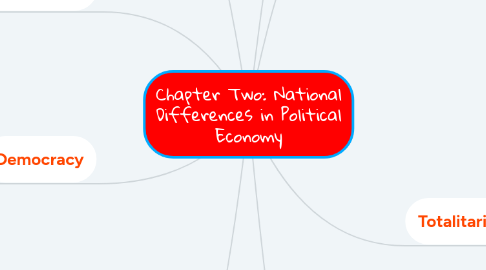Chapter Two: National Differences in Political Economy
by Kathia Campos


1. Socialism
1.1. Roots from Karl Marx
1.1.1. Production, distribution and exchange.
1.1.2. Benefit for a whole society
1.2. Communist
1.2.1. Success from revolution and totalitarian dictatorships.
1.3. Social Democrats
1.3.1. Seeks for the same goal by democratic means
2. Individualism
2.1. Individuals freedom over their economic and political pursuit
2.2. Democratic systems and free markets
3. Democracy
3.1. Political system in which the government is by the people.
3.2. Representative Democracy
3.2.1. Votes on behalf of constituents
4. Economic Systems
4.1. Political ideologies and Economic systems
4.2. Market Economy
4.2.1. Goods and service that a country produces
4.2.2. Supply and Demand
4.3. Command Economy
4.3.1. Goods and services that a country produces
4.3.2. Prices by the governemnt
4.4. Mixed Economy
4.4.1. Supply, demand and prices (Market and Command economy
5. Political Systens
5.1. System of Government in a Nation
5.2. They can be assessed when:
5.2.1. Emphasis of collectivism
6. Collectivism
6.1. A system of giving priority to a group over each individual.
6.2. Connection: Philosopher Plato
6.3. Needs of a society are more important than an individual's freedom
7. Totalitarianism
7.1. Type of government in which ONE person or political party takes control over a whole human life.
7.2. Political Repression
7.3. No free or fair elections
7.4. Censored Media
7.5. Communist T.
7.5.1. Advocates socialism
7.6. Teocratic T.
7.6.1. Religious principles
7.7. Tribal T
7.7.1. Monopolized power
7.8. Right Wing T.
7.8.1. Political freedom is restricted
8. Legal Systems
8.1. Rules, laws, behaviours of a country
8.2. Common Law
8.2.1. Tradition, precedent and customs
8.3. Civil Law
8.3.1. Laws set by codes
8.4. Theocratic Law
8.4.1. Religion

